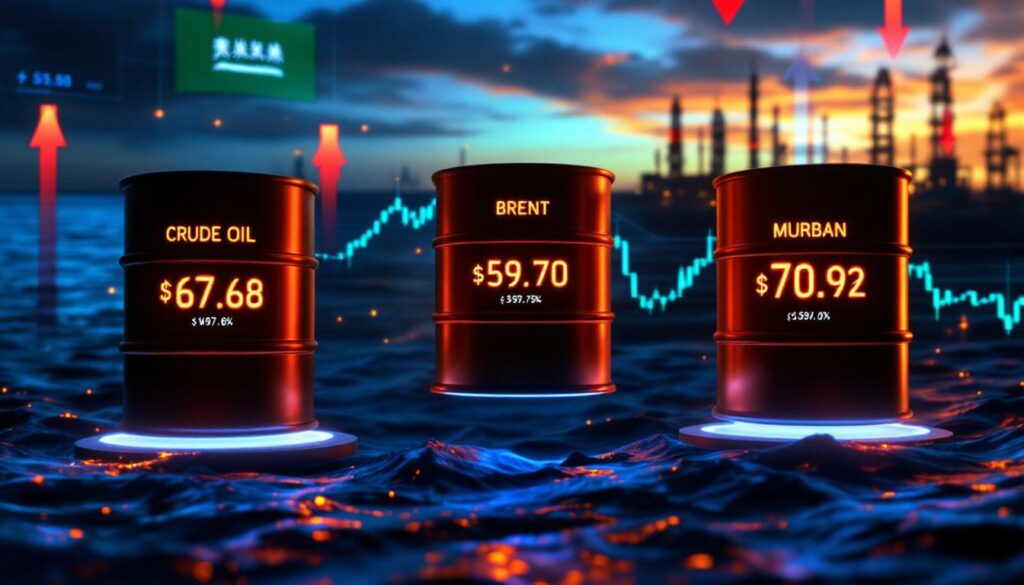What Are Today's Current Crude Oil Prices?
Understanding the Benchmark Crude Oil Prices
The global oil market revolves around key benchmark prices that serve as reference points for trading worldwide. These benchmarks reflect regional supply dynamics, quality differences, and market sentiment.
West Texas Intermediate (WTI)
- Current Price: $67.68
- Daily Change: +1.11 (+1.67%)
Brent Crude
- Current Price: $69.70
- Daily Change: +1.06 (+1.54%)
Murban Crude
- Current Price: $70.92
- Daily Change: +0.77 (+1.10%)
WTI represents light, sweet crude primarily produced in the United States, particularly in the Permian Basin. Brent represents the international standard drawn from the North Sea, while Murban represents the Middle Eastern market as a light, sour crude from the UAE.
Key insight:
Crude oil benchmarks inform global oil markets and pricing trends. WTI and Brent are crucial indicators of economic health and geopolitical stability. Their price movements often precede broader economic shifts, making them vital barometers for investors and policymakers alike.
Regional Price Variations
While WTI, Brent, and Murban serve as the primary global benchmarks, regional crude varieties trade at varying premiums or discounts based on quality, transportation costs, and refining complexity. These regional variations provide important context for understanding the global energy landscape.
Real-time pricing data shows considerable variation across global markets, with prices updating every 10-15 minutes on major platforms like OilPrice.com to reflect the constantly shifting market dynamics.
What's Driving Today's Crude Oil Prices?
Global Demand and Supply Factors Affecting Oil Prices
Several fundamental factors are currently influencing crude oil prices across global markets:
-
Saudi Arabia's export strategy: Saudi oil shipments to China are expected to reach a two-year peak in August 2025, indicating strengthening Asian demand for Middle Eastern crude.
-
OPEC+ production decisions: The oil cartel continues to carefully manage global supply through strategic production adjustments. Recent statements from UAE officials suggest "the oil market is thirsty for more OPEC's oil influence," indicating potential production increases.
-
U.S. inventory fluctuations: A recent spike in U.S. crude oil inventories has generated bearish market signals. The July 2025 inventory build exceeded analyst expectations, creating downward pressure on prices.
-
Refining capacity constraints: Despite OPEC's forecast of a 19.5 million barrel per day increase in global refining capacity by 2050, near-term bottlenecks continue to impact refined product availability and pricing.
Geopolitical Factors Influencing the Oil Market
The oil market remains extraordinarily sensitive to geopolitical developments, with several active conflicts creating significant price volatility:
-
Red Sea shipping disruptions: The Houthis have dramatically escalated their maritime attacks, recently sinking two vessels—the Eternity C and Tutor—within a 72-hour period. These attacks represent what analysts describe as "a qualitative shift from harassment to lethal maritime warfare," employing sophisticated "layered strike packages" combining anti-ship missiles and drone swarms.
-
Russia-Ukraine conflict: Russia has intensified aerial attacks on Kyiv, further destabilizing Eastern European energy security and transportation routes.
-
EU sanctions on Russian oil: The European Union's proposed 19th sanctions package includes a dynamic price cap on Russian oil exports, with a floating cap around $45/barrel linked to global benchmarks. This represents a significant shift from previous static caps.
-
U.S.-Brazil trade tensions: The United States has implemented substantial tariffs—17.5% on Brazilian crude and 50% on refined petroleum imports—as part of broader Trump tariff impact on trade disputes. Brazilian officials have denounced these measures as "politically motivated," linking them to diplomatic friction over President Lula's policies.
Industry insight:
The combined effect of these disruptions risks collapsing the fragile regional détente that had previously kept oil markets relatively stable. Shipping insurance premiums for vessels transiting the Red Sea have increased by over 400% since January, adding significant costs to global energy transportation.
Crude Oil Price Trends: How Do Current Prices Compare Historically?
Comparative Analysis of Recent Oil Price Movements
Today's oil market presents a complex picture when examining various crude blends across global markets. The current pricing data reveals significant variation in both absolute prices and directional trends:
| Crude Blend | Current Price | Daily Change | Trend Direction |
|---|---|---|---|
| Louisiana Light | $70.58 | -1.82 (-2.51%) | ⬇️ Downward |
| OPEC Basket | $71.23 | -0.66 (-0.92%) | ⬇️ Downward |
| Mars U.S. | $71.88 | -1.03 (-1.41%) | ⬇️ Downward |
| Iranian Heavy | $64.96 | -0.76 (-1.16%) | ⬇️ Downward |
| Western Canadian Select | $54.22 | -1.81 (-3.23%) | ⬇️ Sharp Decline |
The data reveals that six out of seven tracked blends show declines, with Western Canadian Select experiencing the steepest drop at -3.23%. This widespread downward trend suggests broader market concerns rather than isolated regional factors.
Highlighted trend:
Most global crude blends, especially heavier oils like Western Canadian Select, experience a downward trend, signaling bearish market sentiment amid inventory oversupply concerns. The steeper decline in heavy/sour crudes reflects their greater sensitivity to market oversupply conditions.
Quality Differentials and Their Market Impact
Price differentials between various crude grades reflect fundamental quality characteristics that impact refining costs and product yields:
-
Light vs. heavy crude: Lighter crudes (like WTI) generally command premium prices as they yield more valuable products like gasoline and diesel with less intensive processing.
-
Sweet vs. sour crude: Lower sulfur content ("sweet" crude) commands higher prices as it requires less desulfurization, an energy-intensive and costly refining process.
-
Transportation considerations: Landlocked crudes like Western Canadian Select trade at steeper discounts due to higher transportation costs to major refining centers.
These quality differentials typically widen during market oversupply conditions, as refiners gain leverage to be more selective about their crude purchases, prioritizing grades that maximize profit margins.
How Does Today's Oil Price Impact Major Economies?
U.S. Reaction and Domestic Impacts
The United States has taken significant policy actions in response to shifting global oil dynamics:
-
Tariff implementation: A substantial 17.5% tariff on Brazilian crude and an even more punitive 50% on refined petroleum imports took effect in July 2025. These measures represent one of the most aggressive US economic tariffs in recent U.S. history.
-
Refining industry consequences: American refiners specialized in processing heavy, sour crude (particularly Gulf Coast facilities) face margin pressure as Brazilian imports become less economically viable. Industry analysts project potential fuel price increases in Q4 2025, particularly in regions dependent on imported feedstocks.
-
Trade relationship strain: Brazilian oil giant Petrobras has begun rerouting cargoes originally destined for the U.S. to alternative markets in India and Southeast Asia, potentially accepting price discounts to maintain export volumes.
China's Economic Growth and Increased Oil Demand
China's energy demand continues to accelerate despite its simultaneous push toward electrification:
-
Transportation sector evolution: The surge in electric truck sales has paradoxically increased overall energy demand as China's logistics network expands. While displacing some diesel demand, the electricity generation requirements have boosted overall fossil fuel consumption.
-
Strategic import diversification: China has strategically increased crude imports from Saudi Arabia while maintaining substantial Russian purchases, effectively playing suppliers against each other to secure favorable pricing terms.
-
Refining capacity expansion: Chinese refiners continue adding sophisticated processing capacity, enhancing their ability to process a wider range of crude grades including challenging heavy/sour varieties.
European Market Stability Amid Complex Energy Dynamics
Europe faces particularly complex energy challenges in the current market environment:
-
Renewable energy shortfalls: Unexpected underperformance of renewable generation assets has forced increased reliance on fossil fuels, creating additional demand for oil and natural gas.
-
Infrastructure investment gap: European grid operators have identified a critical €250 billion investment shortfall needed to support energy transition goals, complicating the continent's ability to reduce fossil fuel dependence.
-
Strategic reserves management: Regional price volatility has prompted several EU member states to tap strategic petroleum reserves to moderate consumer price impacts, raising concerns about long-term energy security.
Expert Insights: Where Are Crude Oil Prices Going Next?
Opinions from Energy Analysts and Market Experts
Leading analysts and market observers offer divergent views on crude oil's near-term direction:
-
Standard Chartered's contrarian view: Their analysts firmly reject popular "phantom barrel" theories about hidden oversupply, stating: "We see no evidence of a hidden surplus in the physical market." They project stable short-term prices within the current range based on physical market fundamentals rather than speculative positioning.
-
International Energy Agency caution: The IEA has issued warnings about longer-term oversupply despite recent seasonal tightness. Their latest market report emphasizes that temporary supply constraints should not obscure structural market imbalances expected to emerge in late 2025.
-
OPEC's strategic messaging: UAE officials have publicly stated "the oil market is thirsty for more OPEC+ barrels," signaling potential production increases while attempting to establish a price floor through careful production management.
Geopolitical & Economic Risks Currently Monitored by Experts
Market analysts identify several critical risk factors that could substantially impact crude oil prices:
-
Red Sea shipping disruptions: The Houthi attacks represent what experts call "a qualitative shift from harassment to lethal maritime warfare." The sinking of two vessels signals an alarming escalation that could severely constrain shipping through this critical chokepoint.
-
Russian export uncertainties: The EU's proposed dynamic price cap mechanism linked to global benchmarks (targeting approximately $45/barrel) creates significant uncertainty around Russian export volumes and destinations.
-
Macroeconomic headwinds: Tightening monetary policies across major economies threaten demand growth, with particular concern about China's property sector struggles potentially dampening energy consumption.
Analyst perspective:
"The combination of geopolitical escalation and inventory builds presents a uniquely challenging forecasting environment. Price volatility will likely increase before directional clarity emerges."
Strategies for Investors & Businesses Amid Oil Price Fluctuations
Proven Approaches to Hedging Price Risks
Organizations exposed to oil price volatility can implement several effective risk management strategies:
-
Futures contracts utilization: Companies can secure price certainty by entering futures contracts that lock in prices for future delivery, essentially trading potential upside for protection against downside moves.
-
Options strategies: More sophisticated hedging approaches using call and put options provide flexible protection with defined cost parameters, allowing organizations to establish price floors while maintaining some upside exposure.
-
Energy transition diversification: Forward-looking businesses are increasingly allocating capital toward renewable energy projects as a strategic hedge against fossil fuel price volatility and regulatory risks.
-
Physical storage optimization: Companies with storage capacity can strategically build or draw inventories based on market contango or backwardation conditions, potentially capturing significant value from temporal price differentials.
Impact on Key Resource Sector Stocks
The Australian resource sector demonstrates varying sensitivity to oil price movements:
-
BHP (ASX:BHP): As Australia's largest diversified resources company, BHP experiences mixed impacts from oil price fluctuations—benefiting in its petroleum division while potentially facing cost pressures in mining operations.
-
Rio Tinto (ASX:RIO): The mining giant's extensive rail and shipping logistics network creates significant exposure to fuel costs, making its margins sensitive to sustained oil price increases.
-
Mineral Resources (ASX:MIN): The company's mining services business faces direct impact from fuel costs, while its lithium operations benefit from higher oil prices as they improve the competitive position of electric vehicles.
-
South32 (ASX:S32): The diversified miner's aluminum operations are particularly sensitive to energy costs, creating a complex relationship with oil prices due to their impact on overall energy markets.
Investment consideration:
Resource stocks historically demonstrate a 0.63 correlation coefficient with Brent crude during supply-driven price spikes, but only 0.21 correlation during demand-driven price increases—a critical distinction for portfolio positioning.
Step-by-Step Guide: How to Track Live Oil Price Trends
Effective oil price monitoring requires systematic approaches to data gathering and analysis:
Step 1: Select Reliable Data Sources
Begin by identifying trustworthy platforms that provide accurate, timely price information:
- OilPrice.com: Offers comprehensive coverage of 150+ global oil prices with updates every 10-15 minutes.
- Bloomberg Energy: Provides institutional-grade data with sophisticated charting tools.
- Reuters Energy: Features global coverage with strong contextual reporting.
- U.S. Energy Information Administration (EIA): Delivers official government data with detailed analytical reports.
- International Energy Agency (IEA): Offers high-quality global perspective with authoritative analysis.
Step 2: Identify Relevant Benchmarks
Different crude oil benchmarks provide insight into specific regions and market segments:
- WTI (West Texas Intermediate): Best for tracking North American market dynamics and U.S. gasoline trends.
- Brent Crude: Most useful for monitoring global oil markets and European fuel price trends.
- Murban Crude: Provides insight into Middle Eastern markets and Asian pricing dynamics.
- Regional blends: Follow specialized grades relevant to your geographic focus or industry needs.
Step 3: Utilize Interactive Charting Tools
Modern platforms offer powerful visualization capabilities to identify meaningful patterns:
- Set up multi-timeframe views (daily, weekly, monthly charts) to distinguish between short-term noise and longer-term trends.
- Apply technical indicators appropriate to commodity markets (e.g., Relative Strength Index, Moving Averages, Bollinger Bands).
- Compare price movements across different crude grades to identify divergences that may signal regional supply/demand imbalances.
Step 4: Establish Price Alerts and Notifications
Leverage technology to stay informed of significant market movements:
- Configure automated alerts for price thresholds, percentage moves, or technical breakouts.
- Subscribe to daily market summaries from trusted analysts.
- Create custom dashboard views that highlight the specific metrics most relevant to your decision-making needs.
Hypothetical Scenario: How Would a Major Supply Disruption Influence Prices?
Scenario Breakdown: Strait of Hormuz Closure by Geopolitical Conflict
The Strait of Hormuz represents perhaps the world's most critical oil chokepoint, with approximately 21 million barrels per day transiting this narrow waterway. A hypothetical closure would create severe market disruptions:
Immediate Market Reaction:
- Price spike magnitude: Analysts project immediate price increases of 20-50% within weeks of confirmation that the strait is fully blocked.
- Market panic dynamics: The initial price movement would likely overshoot fundamentals as traders, refiners, and speculators compete to secure supplies amid extreme uncertainty.
- Futures curve distortion: The market would likely shift into extreme backwardation (higher spot prices than future prices) reflecting immediate supply concerns rather than longer-term fundamentals.
Strategic Response Mechanisms:
- Alternative routing options: Saudi Arabia maintains spare pipeline capacity to bypass the strait, potentially redirecting approximately 5-6 million barrels per day via the East-West Pipeline to Red Sea terminals.
- Strategic reserve deployments: Major consuming nations would likely coordinate releases from strategic petroleum reserves (SPRs), with the U.S. alone capable of releasing up to 4.4 million barrels per day for a limited period.
- Demand destruction effects: Price spikes would trigger immediate conservation behavior and industrial curtailment, potentially reducing global demand by 2-3 million barrels per day through economic responses.
Economic Ripple Effects:
- Inflation impact: Each $10/barrel increase in sustained oil prices typically translates to approximately 0.3% higher global inflation, potentially forcing central banks to adopt more restrictive monetary policies.
- Shipping insurance consequences: Marine insurance premiums would skyrocket, potentially rendering certain trade routes economically unfeasible regardless of physical availability.
- Consumer fuel costs: Retail gasoline and diesel prices would increase sharply, with U.S. gasoline potentially rising $0.75-1.50 per gallon depending on disruption duration.
Historical context:
During the 2019 Hormuz tensions, oil prices spiked approximately 15% in just 10 days despite no actual closure of the strait, demonstrating the market's extreme sensitivity to even threatened disruptions of this critical chokepoint.
Crude
Want to Capitalise on the Next Significant Mineral Discovery?
Discovery Alert's proprietary Discovery IQ model analyses ASX announcements in real-time, providing instant notifications when significant mineral discoveries are announced. Visit our discoveries page to understand how historic discoveries have delivered substantial returns, and position yourself ahead of the market with our 30-day free trial.




